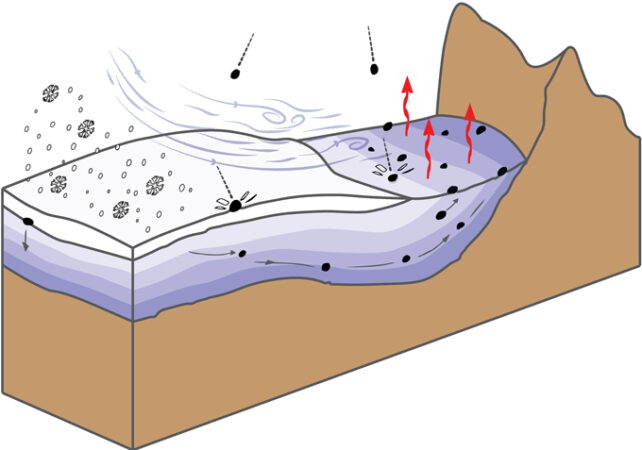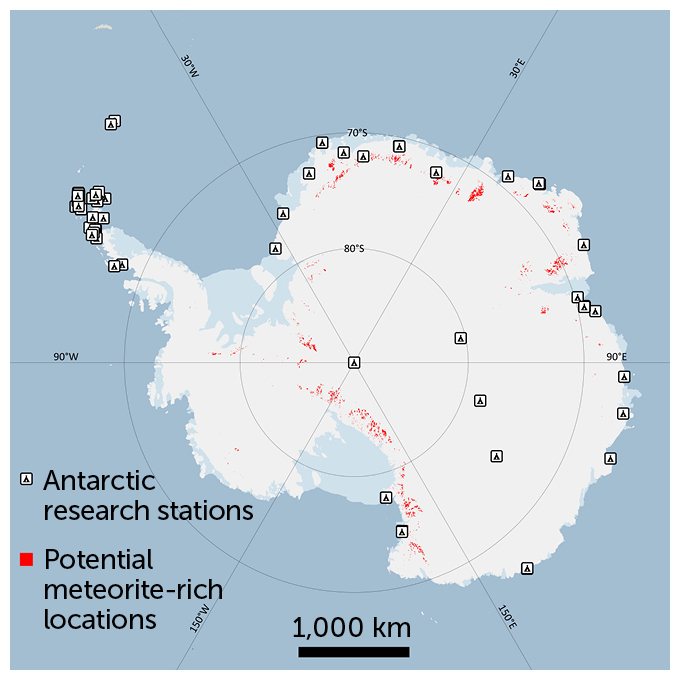The hunt for meteorites may have just gotten some new leads. A powerful new machine learning algorithm has identified over 600 hot spots in Antarctica where scientists are likely to find a bounty of the fallen alien rocks, researchers report January 26 in Science Advances.
Antarctica isn’t necessarily the No. 1 landing spot for meteorites, bits of extraterrestrial rock that offer a window into the birth and evolution of the solar system. Previous estimates suggest more meteorites probably land closer to the equator (SN: 5/29/20). But the southern continent is still the best place to find them, says Veronica Tollenaar, a glaciologist at the Université libre de Bruxelles in Belgium. Not only are the dark specks at the surface starkly visible against the white background, but quirks of the ice sheet’s flow can also concentrate meteorites in “stranding zones.”
The trouble is that so far, meteorite stranding zones have been found by luck. Satellites help, but poring through the images is time-consuming, and field reconnaissance is costly. So Tollenaar and her colleagues trained computers to find these zones more quickly.
Space rocks’ road
This diagram shows what happens when a slowly creeping ice sheet, with meteorites (black dots) embedded in deeper layers, encounters a topographic rise such as a mountain. That obstacle bends the ice sheet’s layers upward, concentrating the space rocks embedded in them into a meteorite stranding zone. In regions where snow turns into water vapor (red arrows) faster than it accumulates, called blue ice areas, these stranding zones are particularly visible.
How meteorite hot spots form  Veronica Tollenaar
Veronica Tollenaar
Such stranding zones form when the slow creep of the ice sheet over the land encounters a mountain or hidden rise in the ground. That barrier shifts the flow upward, carrying any embedded space rocks toward the surface.
Combining a machine learning algorithm with data on the ice’s velocity and thickness, surface temperatures, the shape of the bedrock and known stranding zones, Tollenaar and colleagues created a map of 613 probable meteorite hot spots, including some near existing Antarctic research stations.

Sign Up For the Latest from Science News
Headlines and summaries of the latest Science News articles, delivered to your inbox
Client key* E-mail Address* Go
Thank you for signing up!
There was a problem signing you up.
To date, about 45,000 meteorites have been plucked from the ice. But that’s a fraction of the 300,000 bits of space rock estimated to lie somewhere on the continent’s surface.
The team has yet to test the map on the ground; a COVID-19 outbreak at the Belgian station in December halted plans to try it during the 2021–2022 field season. It will try again next year. Meanwhile, the team is making these data freely accessible to other researchers, hoping they’ll take up the hunt as well.
Marking the spots
Using a machine learning algorithm, researchers trained computers to identify the likeliest locations of meteorite stranding zones across Antarctica. Many of these zones (in red) are located near existing research stations (small tents). The team also created an interactive map to help researchers find these alien rocks.
‘Treasure map’ to find meteorites in Antarctica Veronica TollenaarVeronica Tollenaar
Veronica TollenaarVeronica Tollenaar

